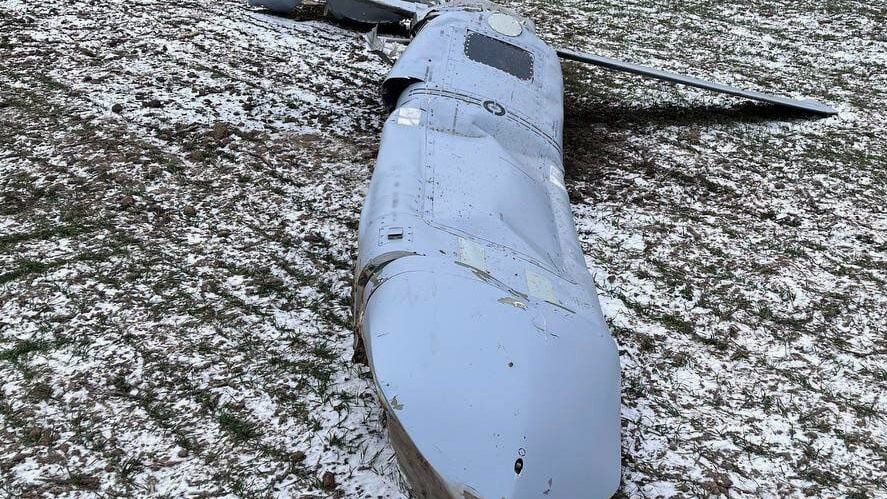
A Russian Kh-101 air launched cruise missile reportedly shot down by Ukrainian air defenses. (Ukrainian Air Force on Twitter)
BELFAST — Weapons researchers have gathered examples of newly-produced Russian cruise missiles that have been used against Ukraine, in what they say is a sign that Russia’s stockpile of munitions has become so thin weapons are being used in the war just a few months after assembly.
The discovery implies that Moscow is facing serious stockpile issues and increased production pressure that “might not be indefinitely sustainable,” according to Damien Spleeters, deputy director of operations at the Conflict Armament Research (CAR) group, a UK based weapons tracking organization. The news comes as Britain warns Russia is trying to rebuild its cruise missile stockpile.
Spleeters revealed to Breaking Defense that during a recent trip to Ukraine, his team recovered parts from a Kh-59MK2 air-to-surface missile that struck Ukrainian territory in March 2023, with CAR tracing production of the weapon to Q4 2022.
That’s a strikingly quick turnaround from production to use, but it isn’t even the fastest rate of use CAR has found. In another case, two Kh-101 missiles were recovered and examined after striking Kyiv in November 2022, with CAR researchers able to determine that one of the munitions was produced in the last quarter of 2022, most likely October.
CAR can be so precise about the provenance of the missiles because the first three serial number digits from both the Kh-101 and Kh-59 are linked to the factory of manufacture, with the next three digits linked to a “certain model,” said Spleeters. “That’s followed by one digit for the quarter of the year and one digit for the year of production.”
Besides Kh-101 and Kh-59 weapons, a wide variety of other Russian air launched cruise missiles have been found in Ukraine including Kh-22, Kh-29, Kh-31, Kh-47M2 Kinzhal and Kh-555 types, according to CSIS.
CAR’s findings line up with broader evidence that Russia’s stockpiles of cruise missiles are thinned out after 15 months of war.
In a May 3 UK intelligence update, the British military said that two air-launched cruise missile strikes against Ukraine, performed April 28 and May 1, were the first time in 50 days that ALCMs were used by Russian forces. According to the report, “both strikes used smaller numbers of missiles than seen in previous attacks, which is likely due to Russian attempts to rebuild its ALCM stockpiles.”
Another piece of evidence that Russia’s stockpiles are thin comes from reports that Russia’s fleet of Su-34s, normally used to launch ALCMs, have instead been operating with “dumb” bombs.
RELATED: A Russian Su-34 accidentally bombed a Russian city. Here’s what it tells us about Putin’s forces.
“I think we have reached a turning point where certain Russian stocks and components are getting low and have to be replenished,” said Spleeters. “From what I have seen of post invasion Kh-59 produced missiles, they are based on a mix of Russian and Western components made before the war, so Russia still appears to be relying on older stockpiles.”
At a wider level, CAR has assessed thousands of Russian weapon components and communication devices recovered in Ukraine, largely it says, manufactured between 2014 and 2021.
“This really indicates that Russia had a very consistent stockpile effort before the invasion, knowing that new export control measures and sanctions would be imposed and trying to be as resilient as they could before starting the invasion,” added Spleeters. “That’s why it will take time to see the effect of sanctions, but they will certainly have an effect for sure.”
US officials, including undersecretary of defense for policy Colin Kahl, have previously predicted that international export controls will make Russian stockpile rebuilding “a lot harder” especially in regard to accessing microchips to recapitalize precision guided missiles and standoff munitions.
Russia has used more than 5,000 missiles and “one way attack drones” since the war started in February 2022 and expended “much of its pre-war stockpile of precision-guided missiles” according to a May 2023 report from CSIS.
The same report, which describes Russia’s missile strike campaign as “strategically ineffective,” identifies potential capability flaws of Russian missiles, including Ukrainian authorities reporting Kh-101 shoot down incidents that call into question the purported stealth characteristics of the weapon.
The Ukrainian Air Force also said in a social media post Saturday that it had successfully downed a Kinzhal hypersonic missile over Kyiv with a Patriot air defense system. Russia has consistently championed the modern munition as one especially difficult to intercept based on a claim it can fly at 10 times the speed of sound.
Pentagon press secretary Brig. Gen. Pat Ryder confirmed on Tuesday that a Patriot system shot down a Russian missile over Ukraine, but would not confirm if it was a Kinzhal or not.
Lockheed, Howmet settle lawsuit over F-35 titanium (EXCLUSIVE)
Lockheed Martin alleged in court filings that Howmet cut off the supply of titanium after the aerospace giant refused to agree to higher prices, threatening production of the F-35.


























